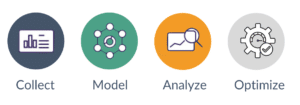What is Media Mix Modeling?
Media mix modeling is a statistical method used to measure the impact of marketing and advertising campaign. This method illuminates how the 4Ps of the marketing mix – product, price, place, and promotion – contribute to a specific goal. By utilizing statistical analysis, media mix modeling enables a thorough understand of how various marketing efforts impact business outcomes such as sales.
The primary objective of MMM is to evaluate multiple models accurately and answer the question “What will happen if you make this change?” Nevertheless, for effective utilization of MMM, aggregated and cleansed data from internal databases and external sources is necessary. Consequently, for each media channel campaign, a numerical value based on ROI is assigned to allocate future spend and create sales forecasts.
Media Mix Modeling Process

As such, the MMM involves the following steps:
1) Data collection: collect first-party data for a more accurate representation of user reactions and behavior in response to your marketing strategy
2) Modeling: MMM works best with digital channels as they are easier to measure. To create a model, choose the dependent & independent variable as well as including controllable variables (ie: price) and uncontrollable variables (ie: competition) and the independent variable.
3) Data analysis & insights: use model from phase 2 to uncover and analyze insights related to marketing campaign
4) Optimization: optimize your marketing mix for future campaigns using your results from phase 3
Media Mix Modeling Example
Now that we have a better understanding of what is MMM and its process, let’s look at it through an example.
Suppose a company wants to determine the most effective media mix to increase sales of is new product. The company has historically used TV, print, and digital advertising, but is considering adding outdoor advertising to the mix. To conduct the media mix modeling analysis, the company would first gather historical data on the performance of each media channel over a specified time period. This data would include metrics such as sales revenue, advertising spend, reach, frequency, and audience demographics.
The company would then use statistical techniques, such as regression analysis and time series analysis, to determine the relationship between the media spending and the sales revenue. The analysis would also examine the impact of factors such as seasonality, promotions, and competitive activity.
Based on the analysis, the company might find that a certain combination of media channels and budget allocation would generate the highest return on investment. For example, the analysis might reveal that increasing the spend on digital advertising and adding outdoor advertising would lead to the highest sales revenue, while reducing the spend on TV and print advertising.
The insights generated by the media mix modeling analysis would help the company optimize its advertising budget and allocate resources more effectively to achieve its marketing goals.
In conclusion, media mix modeling is a valuable tool for marketers to optimize their advertising budgets and improve the effectiveness of their marketing campaigns by identifying the most effective combination of media channels and the appropriate budget allocation for each channel. Indaru can help you elevate your marketing strategy with the latest generation of MMM. For more information, do not hesitate to contact us.
Featured image by Freepik




